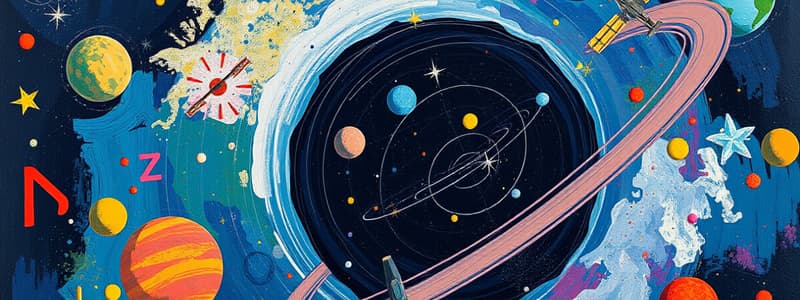Podcast
Questions and Answers
What significant contribution did Galileo Galilei make to astronomy?
What significant contribution did Galileo Galilei make to astronomy?
- He built a powerful telescope. (correct)
- He launched the first satellite.
- He discovered the first exoplanet.
- He orbited the Earth.
Why are satellites important in space exploration?
Why are satellites important in space exploration?
- They capture images of the Moon.
- They provide valuable information about various celestial bodies. (correct)
- They can only observe Earth.
- They enable human spaceflight.
Who was the first American astronaut to travel into space?
Who was the first American astronaut to travel into space?
- Alan Shephard (correct)
- John Glenn
- Neil Armstrong
- Buzz Aldrin
What is one of the primary functions of the Hubble Space Telescope?
What is one of the primary functions of the Hubble Space Telescope?
Which of the following statements is true about the human eye's capabilities in observing celestial bodies?
Which of the following statements is true about the human eye's capabilities in observing celestial bodies?
What did astronauts do with the lunar rocks brought back from the Moon?
What did astronauts do with the lunar rocks brought back from the Moon?
How has the Hubble Space Telescope improved our knowledge of space?
How has the Hubble Space Telescope improved our knowledge of space?
What was the first American satellite launched into space?
What was the first American satellite launched into space?
What advancement in telescope technology did Galileo's telescope lead to?
What advancement in telescope technology did Galileo's telescope lead to?
What can a simple telescope reveal?
What can a simple telescope reveal?
Flashcards are hidden until you start studying
Study Notes
The History of Astronomy
- Galileo Galilei built a powerful telescope 400 years ago, allowing him to observe the Moon's surface and sunspots.
- Galileo's telescope revolutionized the field of astronomy, opening up new avenues for studying space.
- Astronomers continue to build larger, more powerful telescopes for further exploration.
Satellites and Space Exploration
- Explorer 1, the first American satellite, was launched in 1958.
- Satellites have provided valuable information about Earth, other planets, stars, and even the temperature on Saturn.
- Hundreds of satellites currently orbit Earth, conducting diverse scientific research and collecting data.
The Dawn of Human Spaceflight
- Alan Shephard became the first American astronaut in 1961, successfully completing a short, yet historic, spaceflight.
- After Shepherd's mission, more astronauts orbited Earth and landed on the Moon, collecting valuable data and samples.
- Astronauts have analyzed lunar rocks, brought back from the Moon, to understand its composition and potential for supporting life.
The Hubble Space Telescope
- Launched in 1990, the Hubble Space Telescope is a powerful tool for observing distant stars and planets.
- It orbits Earth above the clouds, capturing clear images and providing scientists with valuable insight into the universe.
- The Hubble Telescope has enabled scientists to study planets outside our solar system and observe distant objects.
Looking into Space
- The human eye can observe the Moon, Sun, and Mars.
- A simple telescope can reveal the Moon's craters and Sunspots.
- The Hubble Telescope allows us to see distant objects like planets outside our solar system, stars larger than the Sun, and even exploding stars.
Galileo's Telescope and Astronomy
- Galileo Galilei built a powerful telescope in the early 17th century, revolutionizing astronomy.
- This invention allowed him to make groundbreaking observations, including the Moon's surface and sunspots.
- Today, astronomers continue to build larger and more powerful telescopes to expand our understanding of the cosmos.
Satellites and Space Exploration
- Explorer 1, the first American satellite, launched in 1958, marking a significant milestone in space exploration.
- Satellites play a crucial role in gathering data about Earth, other planets, stars, and even the temperature on Saturn.
- Hundreds of satellites currently orbit Earth, conducting scientific research and collecting valuable information.
The Dawn of Human Spaceflight
- Alan Shephard became the first American astronaut in 1961, successfully completing a historic spaceflight.
- This mission paved the way for future space exploration, including orbiting Earth and landing on the Moon.
- Astronauts have collected valuable data and samples from the Moon, including lunar rocks, which provide insights into its composition and potential for life.
The Hubble Space Telescope
- Launched in 1990, the Hubble Space Telescope is a powerful tool for observing distant stars and planets.
- Orbiting Earth above the clouds, it captures clear images and provides valuable information for scientists studying the universe.
- The Hubble Telescope has enabled scientists to study planets outside our solar system and observe distant objects like exploding stars.
Observing the Universe
- The human eye can observe the Moon, Sun, and Mars without any special equipment.
- A simple telescope can reveal the Moon's craters and Sunspots, providing basic insights into celestial objects.
- The Hubble Telescope allows us to observe distant objects like planets outside our solar system, stars larger than the Sun, and even exploding stars.
Studying That Suits You
Use AI to generate personalized quizzes and flashcards to suit your learning preferences.




